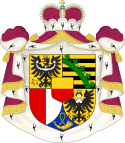1945 Liechtenstein general election
| ||||||||||||||||||||
15 seats in the Landtag 8 seats needed for a majority | ||||||||||||||||||||
This lists parties that won seats. See the complete results below.
| ||||||||||||||||||||
 |
|---|
General elections were held in Liechtenstein on 29 April 1945.[1] Following the "silent elections" of 1939, they were the first to use the new proportional representation system. The Progressive Citizens' Party won eight of the 15 seats in the Landtag,[2] but remained in coalition with the Patriotic Union.[3]
Electoral system
Previously voters had chosen members of the Landtag by writing the names of as many candidates on the ballot paper as there were seats in their constituency.[4] In the new system, parties put forward lists of candidates.[5] The lists served as the ballot papers, with voters submitting their favoured list to the ballot box.[5] Voters could also change the lists by crossing out names and adding others from other lists.[5] After the number of seats a party had won was decided, the candidates who had received the most votes after the voter amendments were elected.[5]
The threshold had been set at 18%, considered to be very high, primarily in order to prevent Nazi parties such as the German National Movement in Liechtenstein (VDBL) from gaining seats in the Landtag.[1]
Results
| Party | Votes | % | Seats | +/– |
|---|---|---|---|---|
| Progressive Citizens' Party | 1,553 | 54.9 | 8 | 0 |
| Patriotic Union | 1,285 | 45.4 | 7 | 0 |
| Invalid/blank votes | 68 | – | – | – |
| Total | 2,906 | 100 | 15 | 0 |
| Registered voters/turnout | 3,088 | 94.1 | – | – |
| Source: Nohlen & Stöver | ||||
References
